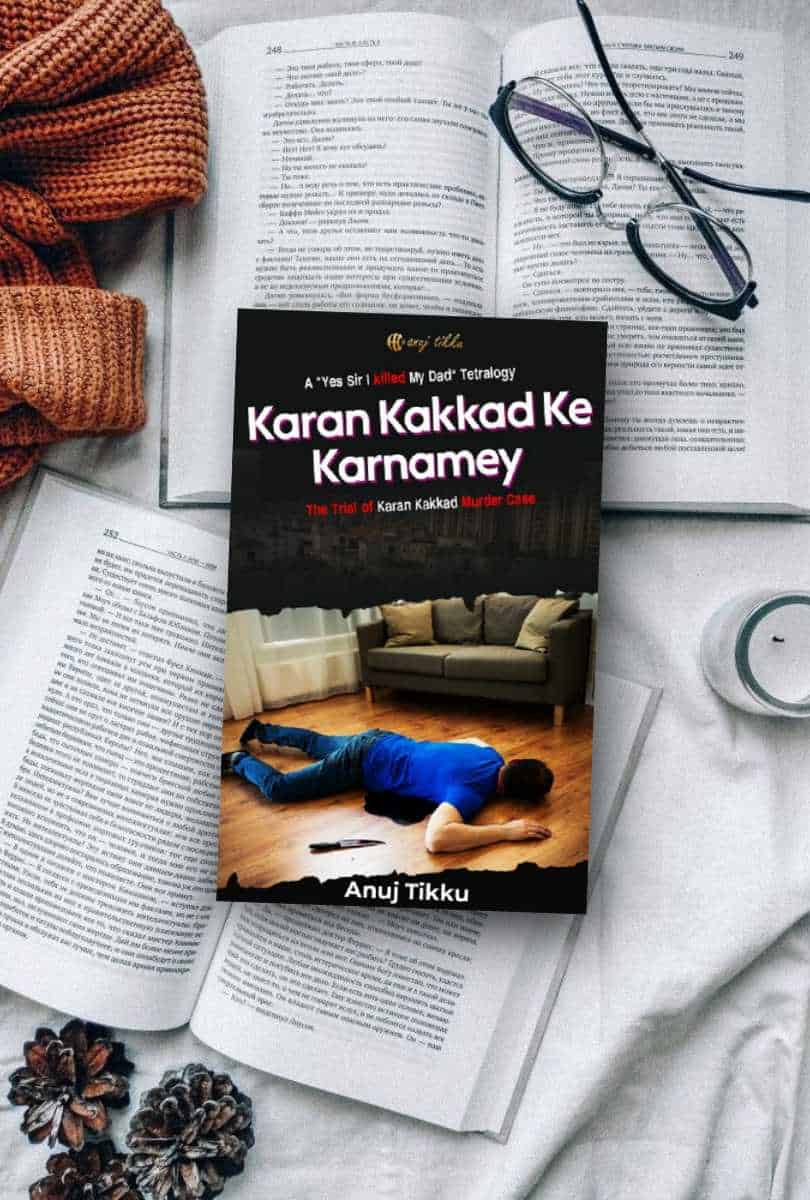SUBJECT: 3.5/5 RESEARCH: 3.5/5 WRITING: 2/5 OVERALL: 2.5/5
“The law takes its own course, leaving the victims’ families in tatters. As for the criminal, he is still alive, no doubt waiting to find his freedom again so that he can find his next victim and kill again. That’s exactly what serial killers like Vijay Palande do, and that’s what they will keep doing if they are not put to sleep for ever. Once a serial killer tastes blood, there is no stopping him…”
– Anuj Tikku, Karan Kakkad Ke Karnamey
Once again, the renowned author returns, bringing with him a new true crime novel centered around the infamous serial killer Vijay Palande.
This latest installment, cleverly titled the “Yes Sir I Killed My Dad tetralogy”, aims to emphasize the brevity of each of its three books.
Among this list of gripping reads, “Karan Kakkad Ke Karnamey” takes its place as the third entry, accompanied by “Hanging Palande” and “Kumbharli Ghat Ke Kankal.”
These books serve as a spin-off from the author’s own captivating true crime tale, “Yes Sir I Killed My Dad,” which has captivated the market and sparked interest because of its potential adaptation into a thrilling true crime web series.
What is the essence of this book?
The book’s subtitle succinctly captures its core focus: the trial of the Karan Kakkad Murder case.
Readers acquainted with Anuj Tikku, the author, will recognize his penchant for delivering gripping true crime narratives tied to his father’s case – the tragic murder of Shri Arun Tikku – and the chilling orchestrator behind it all, serial killer Vijay Palande.
These pages unravel the events that transpired on that fateful day in March, exploring the depths of brutality masterminded by Palande in the killing of yet another innocent man – Karan Kakkad.
The case unfolds with chilling details:
While Vijay Palande inflicted unimaginable devastation upon Anuj’s life by ruthlessly ending his father’s life and even plotting Anuj’s murder, this book delves into another heinous crime committed by the same killer: the murder of Karan Kakkad.
At its core, the book presents a riveting courtroom drama surrounding Case No. 603, which unfolded within the halls of the sessions court in Fort Worth. Delving into the case’s historical records, readers gain insight into the killer’s sinister approach towards Karan Kakkad and the meticulous planning that led to his brutal demise.
Who was Karan Kakkad?
Karan Kakkad, a young man hailing from Delhi, ventured to Mumbai like many others in pursuit of his dreams in the Bollywood industry. At the age of 28, his aspirations were tragically extinguished by the dark forces of greed and money. Karan aspired to become a producer in the vibrant world of Bollywood, while also engaging in work as a model coordinator.
Like the other victims, Karan was also targeted for his money and the valuables that he kept in his possession.
Who is the intended audience for the book?
The book, spanning just under 100 pages, caters to a specific audience. While the language used is simple, it suffers from numerous grammar issues, resulting in confusing writing. As a consequence, regular readers may struggle to fully appreciate the book, as the poor writing and editing significantly diminish the overall reading experience.
The book will capture the interest of several groups:
1. True crime enthusiasts: Readers who find fascination in true crime stories will be drawn to its narrative.
2. Those intrigued by the dark underbelly: Individuals seeking to explore the intricate web of corruption involving politicians, cunning police officers, hardened criminals, and the Bollywood industry will find this book compelling.
3. Courtroom aficionados: Those with an affinity for court proceedings, procedural intricacies, and thorough investigations will appreciate the book’s exploration of the legal system.
4. Fans of concise reads: This book’s brevity will attract readers who prefer short reads.
The writing
The writing style of the book incorporates extensive research, creating an immersive experience akin to perusing an extensive case file. The inclusion of numerous testimonies, witnesses, and cross-examinations throughout the narrative contributes to this sense of depth. However, this can also lead to moments of monotony and weariness for some readers.
Individuals who are not avid fans of legal jargon and terminology, or those unfamiliar with the intricacies of legal language, may encounter some difficulty while navigating the content of this book.
On a positive note, the strategic use of eye-catching pictures serves as a delightful touch, enhancing reader engagement and providing visual stimuli within the pages.
Areas for improvement:
It would have been preferable if the book had undergone more meticulous editing and included a glossary of legal jargon to assist average readers in understanding the various procedures. The writing itself lacks finesse and fails to fully engage the reader. Despite the book’s potential, it falls short of meeting the expectations of its audience.
In conclusion
Karan Kakkad Ke Karnamey is a true crime book that delves into a gripping courtroom drama, exploring the chilling account of a serial killer’s cold-blooded murder of Karan Kakkad.
